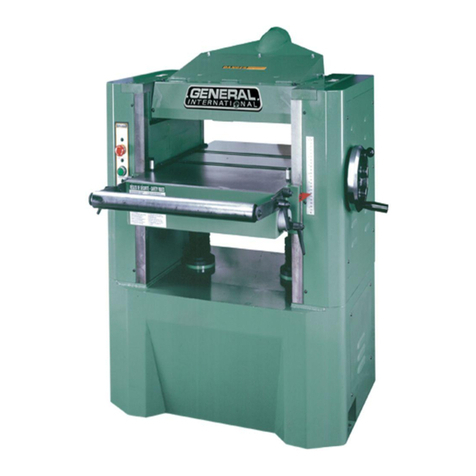
5
RULES FOR SAFE OPERATION
To help ensure safe operation, please take a moment to learn the machine’s applications and limitations,
as well as potential hazards. General®International disclaims any real or implied warranty and hold itself
harmless for any injury that may result from the improper use of it’s equipment.
1. Do not operate this planer when tired, distracted, or
under the effects of drugs, alcohol or any medica-
tion that impairs reflexes or alertness.
2. The work area should be well lit, clean and free of
debris.
3. Keep children and visitors at a safe distance when
the planer is in operation; do not permit them to
operate the planer.
4. Childproof and tamper proof your shop and all
machinery with locks, master electrical switches
and switch keys, to prevent unauthorized or unsu-
pervised use.
5. STAY ALERT! Give your work your undivided attention.
Even a momentary distraction can lead to serious
injury.
6. Fine particulate dust is a carcinogen that can be
hazardous to health. Work in a well-ventilated area
and whenever possible use a dust collector. Wear
face, eye, ear, respiratory and body protection
devices.
7. Do not wear loose clothing, gloves, bracelets, neck-
laces or other jewelry while the planer is in ope-
ration. Wear protective hair covering to contain long
hair and wear non-slip footwear.
8. Be sure that adjusting wrenches, tools, drinks and
other clutter are removed from the machine and/or
the table surface before operating.
9. Keep hands well away from inserts and all moving
parts. Use a push stick to feed stock, and a brush,
not hands, to clear away chips and dust.
10. Be sure that the inserts are securely installed in the
cutter head.
11. Always use clean, properly sharpened inserts. Dirty
or dull inserts are unsafe and can lead to accidents.
12. Inspect stock and remove all foreign objects be-
fore planing. Make sure that any stock you plane
is clean and free of any dirt, nails, staples, tiny rocks
or any other foreign objects that may damage the
planer knives. Only process natural solid wood
boards. Never plane MDF, particle board, plywood,
laminates or other synthetic materials.
13. Do not push or force stock into the cutter head. The
planer will perform better and safer when working at
the rate for which it was designed.
14. Kickback is when the workpiece is ejected at high
speeds by the force of the cutterhead. To minimize
the risk of injury from kickback, use proper feeding
technique and stand to one side, out of the path of
a potential kickback.
15. Select appropriate feed speed for the stock being
planed: high speed for softwood and slow for hard-
woods.
16. Place stock firmly against the table and use suitable
in-feed and out-feed support if stock is too long.
17. Keep guards in place and in working order. If a
guard must be removed for maintenance or clean-
ing make sure it is properly attached before using
the machine again.
18. Use of parts and accessories NOT recommended
by General®International may result in equipment
malfunction or risk of injury.
19. Never stand or lean on machinery. Serious injury
could result if the tool is tipped over or if the cutting
tool is unintentionally contacted.
20. Always disconnect the tool from the power source
before servicing or changing accessories such as
knives, or before performing any maintenance or
cleaning, or if the machine will be left unattended.
21. Make sure that the switch is in the “OFF” position be-
fore plugging in the power cord.
22. Make sure the tool is properly grounded.If equipped
with a 3-prong plug it should be used with a three-
pole receptacle. Never remove the third prong.
23. Do not use this planer for any purpose other than
its intended use. If used for other purposes, General®
International disclaims any real or implied warranty
and holds itself harmless for any injury, which may
result from that use.




























